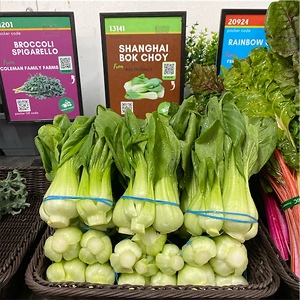


Shanghai Bok Choy
Estimated Inventory, bunch : 39.00
This item was last sold on : 06/29/25
Description/Taste
Shanghai Bok choy is a small cabbage, averaging 10-12 centimeters in length, that has a bulb-like base consisting of clustered stems connected to loosely bunched, oval, flat leaves. The smooth stems, also known as petioles, are thick, firm, pale green, and slightly flattened. The delicate leaves are light to dark green, crisp, and broad with round, even edges, covered in prominent, light green veining. Shanghai Bok choy is tender, aqueous, and crunchy with a mild and slightly sweet, green taste reminiscent of celery and cabbage.
Seasons/Availability
Shanghai Bok choy is available year-round.
Current Facts
Shanghai Bok choy, botanically classified as Brassica rapa var. chinensis, is a small, non-heading cabbage belonging to the Brassicaceae family along with broccoli, kale, and mustard. Native to China and considered to be a baby variety, Shanghai Bok choy is the most common bok choy variety cultivated and sold in the United States and Europe. Shanghai Bok choy is also known as Green Stem Bok choy, Green Bok choy, and Spoon cabbage for its unique pale green, spoon-shaped stems and leaves. The compact plant is bred specifically for its small size, and the consistency of the leaves and stems are more tender and sweeter than their mature counterparts. Shanghai Bok choy has been used in Asian cuisine for many years, but the small cabbage has globally increased in popularity as consumers are learning about its nutritional properties and are incorporating it into both raw and cooked dishes.
Nutritional Value
Shanghai Bok choy is an excellent source of beta-carotene and vitamins A, B, C, and K, which are antioxidants that help the body fight against environmental aggressors. The leaves and stems are also a good source of fiber to stimulate digestion and contain calcium, potassium, vitamin B6, magnesium, and folate to help support bone strength and fight against inflammation.
Applications
Shanghai Bok choy is best suited for both raw and cooked applications such as sautéing, boiling, stir-frying, braising, grilling, and steaming. The crisp nature of the stem and leaves are showcased when chopped and tossed into fresh green salads, or the raw leaves can be mixed into a slaw with carrots and garlic for a mild crunch. In cooked applications, Shanghai Bok choy can be chopped as a filling for potstickers or spring rolls, quickly cooked in stir-fries with other vegetables, mixed into cold noodle dishes, or tossed with cooked meats and rice. The small greens can also be sliced in half and lightly braised or mixed into soups and stews. Shanghai Bok choy pairs well with meats such as poultry, pork, and duck, seafood, tofu, mushrooms, snow peas, cucumbers, carrots, mint, sesame seeds, and sauces such as soy, hoisin, and oyster. The leaves and stems will keep 3-5 days when loosely stored in a plastic bag and kept in the crisper drawer of the refrigerator.
Ethnic/Cultural Info
In Hong Kong, bok choy is a symbol of good luck and prosperity and is often incorporated into wedding banquets and holiday meals. At traditional wedding banquets, guests are served 9-12 lavish courses that are all symbolic of happiness, prosperity, good luck, and are also representative of a dragon or phoenix to celebrate the male and female joining together. In one of the courses served, it is common to pair braised bok choy with abalone in an oyster sauce. In traditional Chinese medicine, bok choy is also seen as a cooling vegetable that can help with calming fevers and coughs. It was traditionally crushed and applied topically to help with rashes and skin irritations.
Geography/History
Bok choy is native to China, originally from the Yangtze River Delta, where it has been cultivated for thousands of years. The exact origins of Shanghai Bok choy are unknown, but since the beginning of cultivation in China, many new varieties have been bred to meet changing consumer demand, especially for baby bok choy varieties. Bok choy was later introduced to Southeast Asia in the 16th century and Europe and North America in the 19th century. Today Shanghai Bok choy is widely cultivated across Asia and Southeast Asia, especially in Japan, China, and Korea, and it is also grown and sold at farmers markets and through specialty grocers in Australia, South Africa, Europe, Canada, South America, the Caribbean, Central America, and the United States.
Featured Restaurants
Restaurants currently purchasing this product as an ingredient for their menu.
| Lauberge Del Mar | Del Mar CA | 858-259-1515 |
| Fort Oak | San Diego CA | 619-795-6901 |
| Trust Restaurant | San Diego CA | 609-780-7572 |
| Beaumont's | San Diego CA | 858-459-0474 |
| Juniper & Ivy | San Diego CA | 858-481-3666 |
| Make Stuff Good | San Diego CA | 949-547-9470 |
| Wolf In the Woods | San Diego CA | 619-851-7275 |
| Plant Based Meals | San Diego CA | 858-255-0590 |
| Lodge at Torrey Pines Main | San Diego CA | 858-453-4420 |
| US Grant Hotel Grill | San Diego CA | 619-232-3121 |
| Espadin | Temecula California | 951-383-5585 |
| Chef Lance Roll | Vista CA | 760-685-2433 |
Recipe Ideas
Recipes that include Shanghai Bok Choy. One

















